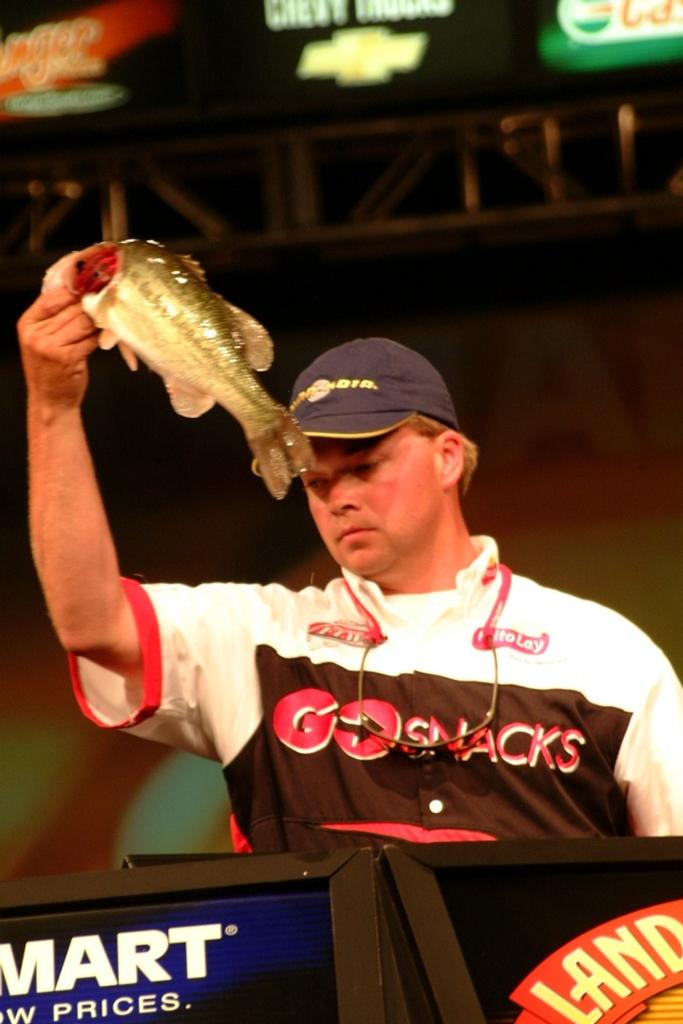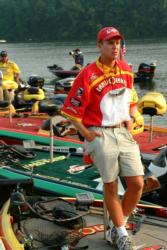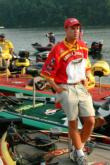Fickle flats

Decatur Flats was pivotal part of FLW Tour event on Wheeler Lake
When bass fishing on Wheeler Lake, consider some sage advice from Muscle Shoals, Ala., bass pro Timmy Horton: “Just think of Lake Wheeler as only being nine miles long.”
Horton, who finished second in the June 18-21 Forrest Wood Open on Wheeler Lake, knows a thing or two about Wheeler. Not only is it his home lake, but he once guided on the fishery as well.
When Horton says Lake Wheeler is only nine miles long, what he means is this: Though the lake is nearly 70 miles from dam to dam, the most consistent bass fishing is found in the five- to 10-mile stretch of water known as the Decatur Flats.
Horton estimates that probably 90 percent of the tournaments on Wheeler are won on the Decatur Flats.
During the FLW event last week, the Decatur Flats produced a bass-fishing fest for a majority of the field. Limit after limit on both the pro and co-angler sides were caught on the prolific flats.
After two days, eight of the top 10 qualifiers had caught their fish from the flats.
So why are the Decatur Flats so productive?
For Horton, the reason is found in one word: M-I-L-F-O-I-L. Milfoil is submerged vegetation that grows in abundance on the flats.
“The flats on Wheeler are a true testament to the positive impact aquatic vegetation can have on a fishery,” he said after collecting $100,000 for his runner-up finish. “There are 70 miles of lake here, and all of the fish are bunched up in one section of grass.”
 “Bass like flats anyway,” said third-place finisher Keith Williams of Conway, Ark., who caught a majority of his fish on the Decatur Flats. “Even without the vegetation, bass will relate to the shallow ditches, humps, ridges, stumps and mussel bars in those flats. You throw in all that lush milfoil and the flats become a super bass magnet. The fish have everything they need; there is no reason to move down the lake.”
“Bass like flats anyway,” said third-place finisher Keith Williams of Conway, Ark., who caught a majority of his fish on the Decatur Flats. “Even without the vegetation, bass will relate to the shallow ditches, humps, ridges, stumps and mussel bars in those flats. You throw in all that lush milfoil and the flats become a super bass magnet. The fish have everything they need; there is no reason to move down the lake.”
Essentially, Decatur Flats includes the water between the Highway 31 Bridge and the Browns Ferry Nuclear Plant. In that portion of the lake, on both sides of the river channel, milfoil grows along the ridges and humps of the flats.
“Really, anywhere in that area that has milfoil is considered a flat by the locals,” Horton added.
Another thing that helps keep this section of the lake so productive is the number of local tournaments held in nearby Decatur which release fish back onto the flats.
But don’t be fooled by this small stretch of water. Even though it is a scant 15 percent of the waterway, it is the most complex area on the lake.
“The flats are intricate and complex,” said Horton. “Normally, I am one to get away from a crowd in tournaments. But on Wheeler, the pressure does not bother me because I know there are so many little subtleties contained within those flats. Compared to the rest of the lake, it’s a small area, but within that small area is a vast fishery that is as complex as the rest of the lake.”
Tournament strategy on Wheeler essentially boils down to a committed flats fishing game plan or finding fish elsewhere. But when seeking alternatives to the flats, anglers frequently experience what Keith Williams experienced last week.
“I spent a lot of practice trying to find something other than the flats,” Williams said. “I practiced in many of the creeks up river. What I found was that I could catch fish up in those creeks, sometimes 13 or 14 pounds worth, but they took me all day to catch and I was 50 miles up the river and then another 20 miles up a creek. I could have caught the same thing in half the time right there on the flats near Decatur.”
On the first morning of the tournament, Williams tried to make his creek strategy pay off. He went to a creek, caught a limit early and then returned to the flats in the afternoon only to cull out every creek fish with 13 pounds and 7 ounces of flats fish.
“It’s a waste of time to try to out-fish those flats fish somewhere else,” he conceded. “The next day I just stayed on the flats all day and I caught 15 pounds to make the cut.”
 Ironically, it was tournament winner Aaron Martens of Castaic, Calif., who made a different fishing strategy pay off. Martens, who lives in north Alabama half of the year, abandoned the flats and decided to spend his entire practice time putting together a pattern that involved current on main river points.
Ironically, it was tournament winner Aaron Martens of Castaic, Calif., who made a different fishing strategy pay off. Martens, who lives in north Alabama half of the year, abandoned the flats and decided to spend his entire practice time putting together a pattern that involved current on main river points.
Martens was trying to avoid the pressure on the flats, but he was also trying to avoid the fickleness of the flats that can leave an angler high and dry with a condition change.
“I had to commit my whole 6 days of practice either to the flats or to something else, but I could not do both,” Martens said. “Those flats are complicated; it takes me at least five days to figure out how the fish are relating to the grass in all situations. Every time the current changes or the wind changes, those fish reposition. Catching them one day is not a problem, but a slight condition change makes it a whole new game out there the next day. You have to know how the fish are going to change. So I decided to spend my practice looking for something more stable than the flats.”
Martens’ observation became a truism for Kevin VanDam who finished fourth on the flats.
 “It’s amazing how much those bass in the flats change from day to day,” VanDam said. “The fish live in bunches or groups out there. But they were repositioning each day depending on how the current was moving over the ridges. Every day I had to find where they had moved to before I could really catch them.”
“It’s amazing how much those bass in the flats change from day to day,” VanDam said. “The fish live in bunches or groups out there. But they were repositioning each day depending on how the current was moving over the ridges. Every day I had to find where they had moved to before I could really catch them.”
Williams also experienced the flats’ fickleness. On day three, he brought in a small limit weighing 7 pounds, 3 ounces.
“I have no idea what happened,” Williams said about day three. “The wind and current changed and the fish just vanished.”
Martens gambled his practice time on finding something more stable and it worked. After spending his entire practice checking dozens of main river points, he settled on one point that featured gravel rock, stumps, mussel beds and – the key ingredient – current which positioned the fish each day.
The bait responsible for a majority of his catch was a weightless Kinami Flash sinking stick bait in watermelon-pepper with a 3/0 straight shank hook.
The other finalists – including Horton, Williams and VanDam – all finished within 2 pounds of Martens out on the flats.
In the grass, Texas-rigged 10-inch worms were big producers for both VanDam and Horton, while Williams favored a Texas-rigged tube.
VanDam also reported catching his bigger fish in the grass on a Strike King Series 5 crankbait.
In the finals, Horton and Williams scored good catches on mussel shell beds that were on the edge of the flats near the river channel. Grass was nearby, but both said the fish were relating more to the shell beds than the grass.
Horton dragged a 1/2-ounce Booyah jig (black-blue) with a Yum watermelon chunk over shell beds for his final-round catches.
After struggling in the grass on day three, Williams moved out toward the river and cranked a Norman DD 22 crankbait on shell beds on the final day to bring in the final day’s biggest limit of 17 pounds, 4 ounces.
“If I had it to do over again, I would have spent more time looking for shell beds along the edges of those flats in practice instead of trying to find fish in creeks,” Williams said. “One thing I have learned about Wheeler, you don’t have to stray far from the flats to find fish.”